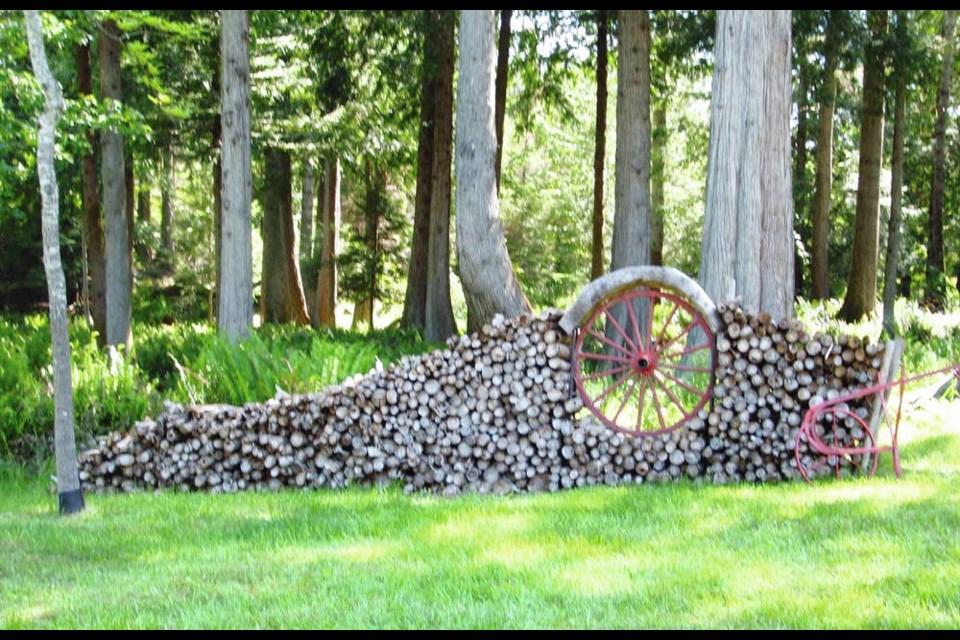Broken any crockery lately? I recently caused a beautiful blue ceramic pot to tumble off a table and break, The pieces are now added to a collection of chipped, cracked and dismembered plates, bowls, saucers, mugs and tea pots that I’ve been reluctant to put in the trash.
I’ve recently come across a way to use these bits and pieces as quirky points of interest and whimsy in the garden.
The idea is not my own, but from observations on a stroll through the fascinating Denamn Island garden of Des Kennedy and his partner Sandy. Tucked into spaces between the shrubs and perennials were arrangements of plates and pieces of china, artfully arranged, usually on slightly sloping ground above main pathways, for optimum pleasure in viewing the displays.
The re-use of these broken things represents perfectly the frugal simplicity and no-waste lifestyle of the property owners, who tend the land with thoughtful care and reap from the soil a year-round abundance of fruits and vegetables for soups and sauces, hearty meals and even wine.
Since that visit, I’ve begun gathering together the discarded crockery I’ve saved. I’m also viewing with new eyes an old enamelled colander I’d purchased decades ago in a countryside shop selling various retro items.
Now that it has developed too much rust for kitchen use, I could line the colander with newspaper or pieces of old row cover fabric, fill it with potting mix, plant sedums or sempervivums (hen-and-chicks) in it and add the little display to a long, path-side collection of these easy, almost indestructible plants. An old dish drying rack could be put to a similar use.
Perhaps the re-use, recycle, and generally frugal way of life is endemic to Denman Island. In another garden on the island’s Conservancy tour this year there was, stationed by the home’s front porch, a peony or tomato cage, painted red, set upside down and filled with rocks to stabilize a long piece of driftwood in the shape of a long-necked bird. Now, I have “designs” on my collection of old wire tomato cages.
Once a person gets started on this track, perhaps there is no end of ways to recruit into new life all sorts of items otherwise destined for being discarded.
Whimsy and enchantment. In many of the gardens on the Denman Island tour, among all the seasonal flowers I noticed some long familiar residents of my own garden beds. There were masses of California poppies that had obviously self-sown over the years to display flowers from pale to deep, rich orange. They mingled companionably with shrubs and perennials.
There were foxgloves, mallows, and the vigorously self-sowing dame’s rocket (Hesperis matronalis), a biennial plant with sweet-scented flowers. It’s one of the many traditional “Mary” plants.
It was in the Kennedy garden that humour and whimsy showed their most light-hearted faces, beginning with the sign at the garden’s entrance: Non Compost Mentis.
The property is sprinkled with artful touches The arrangements of colourful crockery included a row of miniature teacups and saucers perched along a low hedge. At an edge of a wooded area an old wheel has been staged as the centrepiece, topped by a length of curved driftwood, of an artfully arranged wood pile — a playful piece of sculpture, homestead style.
Maggot defense. One of the most common vegetable pests is a small grey fly, rarely noticed, that lays eggs on the soil beside the stems of cabbage family plants. The eggs hatch into maggots that burrow into the roots, causing stunted growth and wilting, even if there is adequate moisture in the soil.
My prevention measure of choice is to arrange a lightweight, floating row cover over the plantings. The cover prevents both the cabbage maggot fly and the cabbage butterfly from accessing the planting.
Other barriers often used are squares or circles of cardboard, several newspaper layers or something similar, cut into the centre and fitted snugly around the stems of broccoli, cabbage, cauliflower and Brussels sprouts.
In one of the Denman Island tour gardens I saw a variation of the barrier theme — a rigid circle that looked like a ring cut from a large plastic jug sunk into the soil around each broccoli plant, with a scrunched up piece of lightweight row cover inside.


